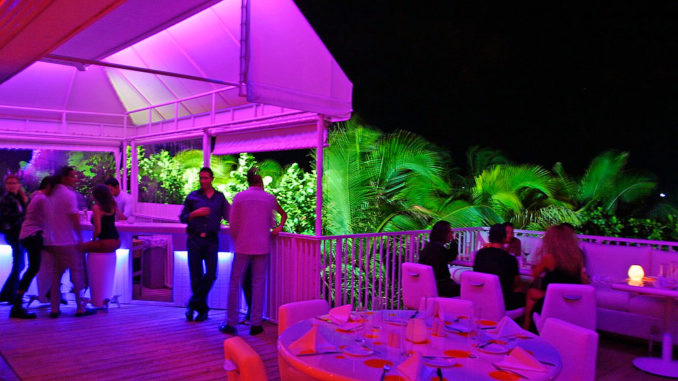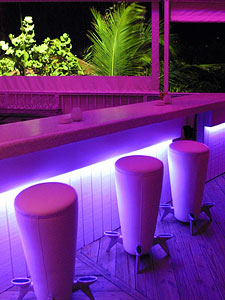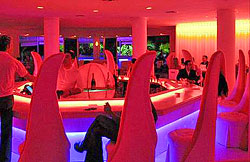
Ascending the winding stairway leading up to Pearl is a teasingly sensual journey that lingers in the mind. Luminous gauzy curtains emanate gentle wafts of music as you are increasingly engulfed in a heavenly neon light. At the pinnacle, in full view of the main room, you see a breath-taking design that is unique in all of South Beach—a design by Stephane Dupoux.
“I see things, that’s why I do what I do,” says Dupoux, owner of the design firm Sculptors of Space. Serious, intense, very French, and very prolific, Dupoux is responsible for the interiors of virtually the entire French-expatriate-owned nightlife scene in South Beach. Opium, Cafe Tabac, Touch, Nikki Beach Club, The Living Room, and The Strand are all by the hand of Stephane Dupoux.
Dupoux associates the ambiance of Pearl with classic 1960’s movie set designs such as A Clockwork Orange and Barbarella. “Orange light is best for the skin,” Dupoux avers, and indeed, Pearl’s guests are bathed in an eerily lovely light reminiscent of 2001: A Space Odyssey. With fur-lined walls awash in waves of white and orange, the precise degree of care and originality that have gone into making Pearl such a lovely space isn’t readily apparent at first view. It may take several visits before one is sufficiently attuned to Pearl’s design to notice special touches like the swing, a signature feature of the man responsible for Pearl’s celestial splendor.
“Neon is associated with tackiness,” Dupoux admits, “but I wanted to use it, because it gives an even glow.” The room is lit by a succession of floor-to-ceiling linen drapes imbued with silver threads; the drapes are trimmed in white fur at the top and bottom, which mutes the orange at the top and purple neon at the bottom.
Round hanging mirrors that complement tables nearest the walls are designed to enhance and soften the space. What’s not so readily apparent, however is that these mirrors are precisely positioned so that diners facing the walls need only glance a few degrees upward to have a complete view of the main lounge and all that transpires behind them during the course of the evening.
Hanging rings through which video projectors display trippy visuals and film snippets; bubbled walls; a sunken, circular champagne bar, all leave first-time visitors in awe of Pearl’s design. The locally made, signature white epoxy tables with large orange polka dots, were recently loaned out to Moda in Miami for the Fashion Week of the Americas tent. And the linchpin of this confederacy of roundness is a giant linen pearl—cable-suspended and filled daily by an electric fan—that hangs directly over the lounge area.
 Dupoux’s boundless inspiration springs from a myriad of sources, even including a prior trip to the Everglades. One of the most interesting aspects of the décor is the way images and even actual elements of the outdoors are interwoven with kitschy or manmade materials: a terrazzo bar top is lined with vinyl on the face of the bar; conch shells cut in half are the inspiration for the tall bar chairs, covered in white shag which was shipped to Italy to be dyed orange. Vinyl (the menus, the face of the bar) and white leather (chairs and barstools) abound, but so do found natural objects. The lounge sofas are framed with “Bahamian-Key Westy” wood painted white, and an actual piece of driftwood serves as the reception table. “I’m always trying in my work to bring the outside in,” says Dupoux, who spends his free time in sporty, outdoor activities like windsurfing and kiting, ‘so you always feel [a connection to] outside.”
Dupoux’s boundless inspiration springs from a myriad of sources, even including a prior trip to the Everglades. One of the most interesting aspects of the décor is the way images and even actual elements of the outdoors are interwoven with kitschy or manmade materials: a terrazzo bar top is lined with vinyl on the face of the bar; conch shells cut in half are the inspiration for the tall bar chairs, covered in white shag which was shipped to Italy to be dyed orange. Vinyl (the menus, the face of the bar) and white leather (chairs and barstools) abound, but so do found natural objects. The lounge sofas are framed with “Bahamian-Key Westy” wood painted white, and an actual piece of driftwood serves as the reception table. “I’m always trying in my work to bring the outside in,” says Dupoux, who spends his free time in sporty, outdoor activities like windsurfing and kiting, ‘so you always feel [a connection to] outside.”
The rest rooms (whose function is most closely allied with nature) also feature unique touches that the average guest, unfortunately, is likely to miss. The ceiling is bamboo; the eggnog-colored walls get their stucco-like texture from a mix of plaster and hay (as in horses) and the sink is an old, epoxied canoe.
All in all, the lounge, formerly an unassuming burger joint atop Penrod’s (the outdoor deck is the only feature of the old space that’s been retained), required $1,200,000 and six months to blossom. Owner Eric Omores left Dupoux and his team pretty much to their own devices. “Eric gives me free rein; it’s one of my conditions,” says the designer, who radiates a strong individuality and singularity of purpose as well as a gentle courtliness. “I trust myself more and more,” he says of his design choices, one of which was to have the DJ booth elevated and facing the room. “The DJ is the [life] blood of a space; he has to see entire room, feel the crowd,” Dupoux says, and in fact the music, which ranges from 1960s French yeye music, to new romantic, to electronica, is one of the major elements of the space’s presentation.
 And then there’s the food. Dupoux, who had a hand in choosing the menu, finds that seafood perfectly complements the décor: “Airy foods adapt well to space.” His particular favorites are the lobster beurre fondue with shaved fennel and asparagus salad on a chive potato pancake with white truffle vinaigrette, and the miso-marinated chicken sea bass with lemongrass, crab wonton, grilled shiitake salad, and carrot-ginger emulsion.
And then there’s the food. Dupoux, who had a hand in choosing the menu, finds that seafood perfectly complements the décor: “Airy foods adapt well to space.” His particular favorites are the lobster beurre fondue with shaved fennel and asparagus salad on a chive potato pancake with white truffle vinaigrette, and the miso-marinated chicken sea bass with lemongrass, crab wonton, grilled shiitake salad, and carrot-ginger emulsion.
The chef could hardly fail to heed Dupoux’s suggestions, as the designer hails from Provence, where food was invented. He grew up in a family of artists, was oil painting by age six, and is now married to a furniture designer for residential spaces. Like many of us, he came to South Beach a few years ago for a vacation that turned into his life.
Dupoux tries to complete one project every three months, and these days he’s hard at work on several new ones: an as-yet-unnamed space (we promised not to tell) expected to open mid-August on Lincoln Road across from 320, and another Pearl in Las Vegas—with a completely different design. “I had a vision of cactus, riders on the storm, skulls—but done in a different way.” Naturally.
